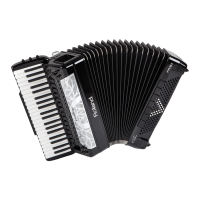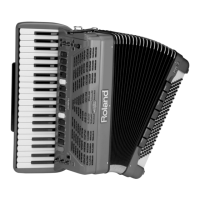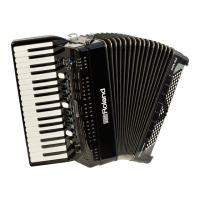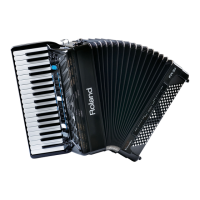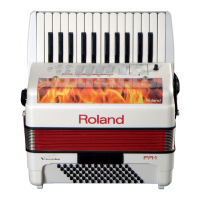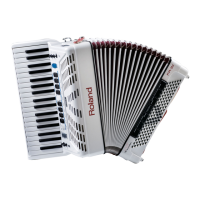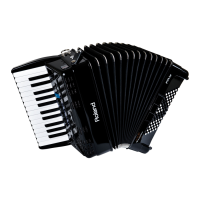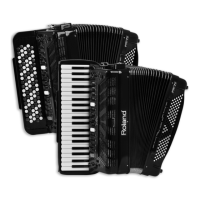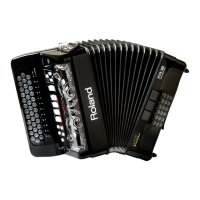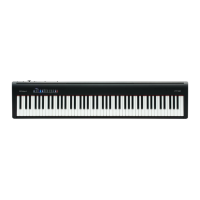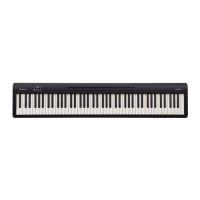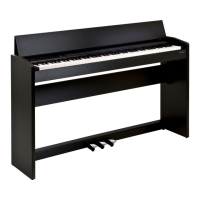Menu Options
100
Parameter Value Explanation
Index Register 1~57 Assign a icon to your Set.
13.7 Name
This page allows you to name the currently
selected Set for easy reference while performing
with the FR-8x.
The FR-8x suggests the name of selected Set.
1. Use the [DATA/ENTER] knob to enter the desired name.
See “How to type a name in FR-8x” (p. 31).
2. Press [EXIT/JUMP] button to exit from the selection.
14. System
The “SYSTEM” group contains parameters that are related to all Sets
and all sections: they apply to the FR-8x as a whole.
The parameters can be saved to the System area.
Press [UP] and [DOWN] simultaneously to select the value that is
indicated as “Default setting”.
Introduction to System Parameters
The settings you perform here apply to all Set and all sections.
IMPORTANT NOTE
The FR-8x internal memory remembers your settings while the
FR-8x is switched on. While editing, there is no absolute need
to save your settings. Be aware, however, that all changes are
lost when the FR-8x is switched o.
See “How to Save System Parameters” (p. 117) to save your
changes. Also be sure to read “Important remark about saving
your settings” (p. 70).
14.1 Dynamic Bellows Behaviour
This parameters allows you to specify how the
FR-8x should respond to the bellows’s movements.
.
Parameter Value Explanation
STATUS
O, On
Default: On
The Dynamic Bellows Behaviour technol-
ogy allows to open and close in real time
the overall “air hole” (overall amount of air
going into / out of the bellows) considering
the selected register and the number of
played notes.
Select “O” if you want a xed bellows
resistance without considering the selected
register and the played notes. See also the
“RESISTANCE” parameter below.
RESISTANCE
-64~0+63
Default: 0
Positive values increase the bellows
resistance and negative values decrease the
bellows resistance.
If “STATUS” parameter is “On”, the
“RESISTANCE” adjust the bellows resistance
considering the selected register and the
number of played notes.
If “STATUS” parameter is “O”, the
“RESISTANCE” adjust the bellows resistance
(the force needed to push and pull it).
Parameter Value Explanation
BELLOWS
CURVE TYPE
Fixed Low,
Fixed Med,
Fixed High, X-
Light, Light,
Standard,
Heavy,
X-Heavy
Default:
Standard
• “Fixed Low”, “ Fixed Med”, “ Fixed High”:
There are three “Fixed” curves that
always use the same value, no matter
how hard or lightly you push/pull the
bellows (no dynamic control). “Low”
means that a low value is used, “Med”
represents a medium value and “High”
a high value. When you select one of
these three options, you do not need to
move the bellows in order to hear the
notes you play.
• “X-Light”: requires even less strength
(the “X” stands for “extra”).
• “Light”: means that you do not need to
push/pull hard to achieve a meaningful
eect.
• “Standard”: refers to a normal response.
• “Heavy”: provides a greater variety of
nuances.
• “X-Heavy”: is even more detailed.
14.2 Layout
This parameters allows you to specify the layout of
the Bass and Chord board and the Right Hand
(Treble Mode) layout.
Parameter Value Explanation
BASS &
CHORD
MODE
2 Bs Rows,
3 Bs Rows A-7th,
3 Bs Rows A-5 dim,
3 Bs Rows B-7th,
3 Bs Rows B-5 dim,
3 Bs Rows Bx-7th,
3 Bs Rows Belgium
Default: 2 Bs Rows
This parameter allows you to specify
the number of button rows available for
playing bass notes. The default is 2 bass
rows and 4 chord rows.
By selecting “3 Bs Rows”, you thus gain
20 bass buttons (an entire row) and lose
the “dim” chord buttons but that may
just be more convenient for you.
See “BASS & CHORD TABLE” (p. 102).
There are four “3 Bs Rows” options:
“A-7th” and “B-7th” mean that the 6th
chord row plays seventh chords (“7”)
that don’t contain the fth. In the case
of a C7 chord, you therefore hear C-E-Bb
(but not the G).
“A-7th” and “B-7th” dier in the
arrangement of the bass notes (see the
illustration on page p. 100).
The “Bx-7th” option reverses the “B-7th”
settings (from right to left), so that
the C3 note moves from 9th to 12th
position.
NOTE
This shift does not apply to Free
Bass mode, which is an altogether
dierent mode.
The “A-5dim” and “B-5dim” options
mean that those seventh chords don’t
contain the root note. A C7 chord is then
sounded with the notes E-G-Bb (but not
the C).
“A-5dim” and “B-5dim” dier in the
arrangement of the bass notes.
NOTE
The FR-8x is supplied with several
reference caps designed to help you
locate the bass and chord buttons
without looking at them.
See “How to Remove and Insert
Reference Caps” (p. 26).
